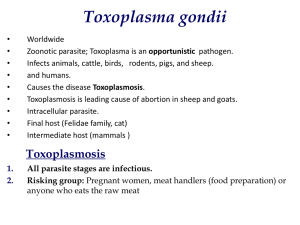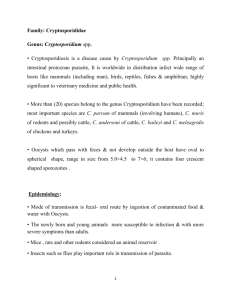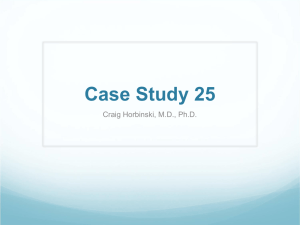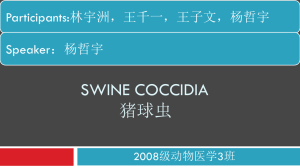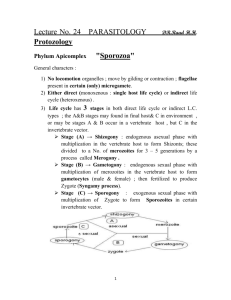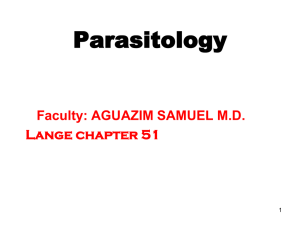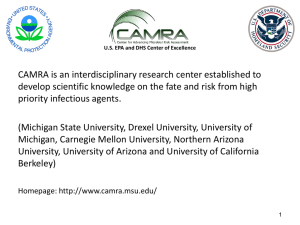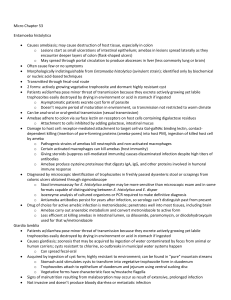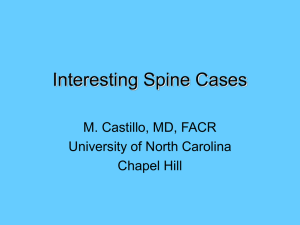parasite
advertisement
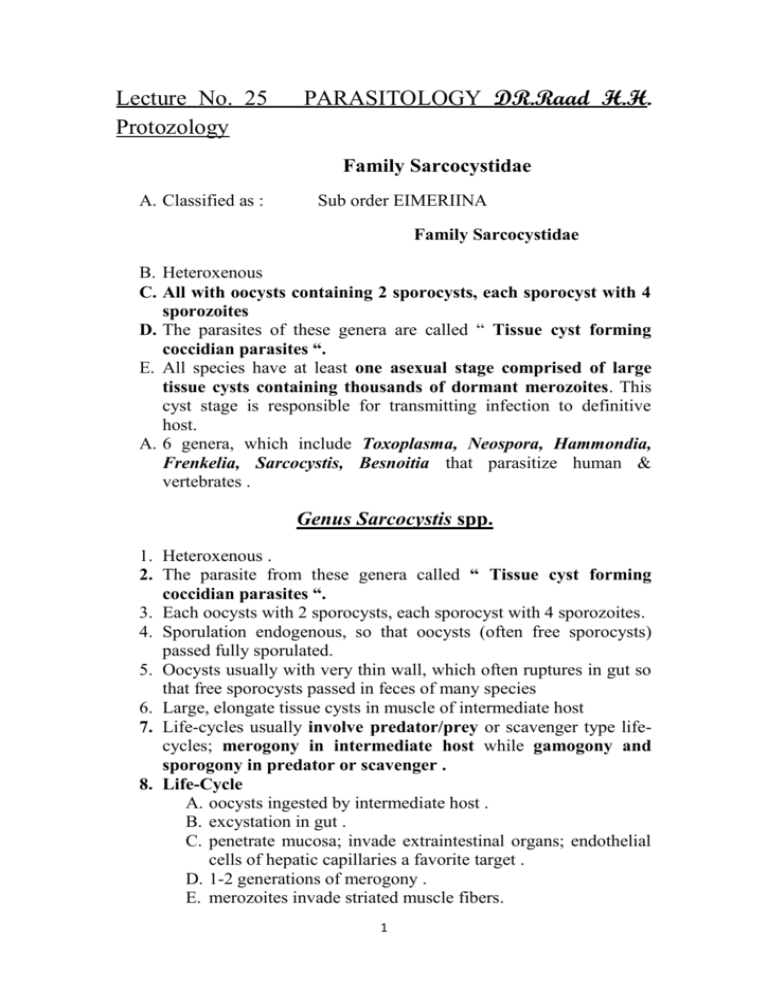
Lecture No. 25 Protozology PARASITOLOGY DR.Raad H.H. Family Sarcocystidae A. Classified as : Sub order EIMERIINA Family Sarcocystidae B. Heteroxenous C. All with oocysts containing 2 sporocysts, each sporocyst with 4 sporozoites D. The parasites of these genera are called “ Tissue cyst forming coccidian parasites “. E. All species have at least one asexual stage comprised of large tissue cysts containing thousands of dormant merozoites. This cyst stage is responsible for transmitting infection to definitive host. A. 6 genera, which include Toxoplasma, Neospora, Hammondia, Frenkelia, Sarcocystis, Besnoitia that parasitize human & vertebrates . Genus Sarcocystis spp. 1. Heteroxenous . 2. The parasite from these genera called “ Tissue cyst forming coccidian parasites “. 3. Each oocysts with 2 sporocysts, each sporocyst with 4 sporozoites. 4. Sporulation endogenous, so that oocysts (often free sporocysts) passed fully sporulated. 5. Oocysts usually with very thin wall, which often ruptures in gut so that free sporocysts passed in feces of many species 6. Large, elongate tissue cysts in muscle of intermediate host 7. Life-cycles usually involve predator/prey or scavenger type lifecycles; merogony in intermediate host while gamogony and sporogony in predator or scavenger . 8. Life-Cycle A. oocysts ingested by intermediate host . B. excystation in gut . C. penetrate mucosa; invade extraintestinal organs; endothelial cells of hepatic capillaries a favorite target . D. 1-2 generations of merogony . E. merozoites invade striated muscle fibers. 1 F. form elongate cysts, termed sarcocysts, each filled with numerous slow dividing merozoites termed bradyzoites. Division of the bradyzoites via endodyogeny within dividing zoites termed metrocytes . G. sarcocysts gradually increases in size and numbers of bradyzoites increase in number . H. sarcocyst ingested by carnivore or scavenger . I. bradyzoites penetrate mucosa and usually enter lamina propria . J. macrogametes and microgametocytes develop. K. flagellated microgametes produced by microgametocyte; exit and and penetrate macrogamete . L. zygote lays down resistant wall; endogenous sporulation. M. oocysts gradually liberated in feces over period of weeks. 9. Most species not pathogenic; very little immunity develops in definitive host 10.Representative species A. Sarcocystis bertrami (equine/canid) B. Sarcocystis cruzi (bovine/canine) C. Sarcocystis capracanis (goats/canids) D. Sarcocystis fayeri (equine/canid) E. Sarcocystis hirsuta (bovine/feline) F. Sarcocystis hominis (bovine/human) G. Sarocystis muris (mouse/felid) H. Sarocystis tenella (sheep/canid) 2 S. neurona life cycle: Species of S. hominis and S. suihominis are genetically programmed to complete their life cycles in specific intermediate hosts or within closely related host species. For example, sporocysts of S. hominis infect cattle but not pigs whereas those of S. suihominis infect pigs but not cattle. Sporocysts of S. ovifelis from cats and S. ovicanis from dogs infect sheep but not cattle or goats. Sporocysts of S. hirsuta from cats infect cattle but not sheep. However, S. cruzi from dogs can infect cattle (Bos taurus), water buffalo (Bubalus bubalis), and bison (Bison bison) Dogs serve as definitive host for S. cruzi, but humans do not. Humans can serve as definitive hosts for S. hominis , and S. suihominis (intestinal sarcocysts in humans). Humans appear to serve as intermediate hosts for Sarcocystis lindemanni (intramuscular sarcocysts in humans) perhaps acquiring infections by ingesting sporocysts excreted by predators of nonhuman primates. 3 Humans acquire intestinal sarcocystosis from eating Sarcocystisinfected meat. Diagnosis by examination of tissues from abattoirs, a high percentage of cattle worldwide are infected with sarcocysts, with those of S. cruzi (infectious from cattle to canines) being the most prevalent and easiest to identify histologically . Toxoplasma gondii 1. 2. 3. 4. 5. 6. Facultatively heteroxenous Definitive hosts felids /(cats) Intermediate hosts over 350 known species of mammals and birds Tissue cysts throughout body, especially concentrated in CNS. Tissue cysts generally spherical Life-cycle in felids (definitive hosts ): A. oocysts, or tissue cysts from infected intermediate hosts, ingested by cats. B. sporozoites (or bradyzoites if from cysts) penetrate intestinal epithelial cells C. 5 generations of merogony in gut D. macrogametes and microgametocytes form E. flagellated microgametes liberated from microgametocytes; penetrate macrogamete F. zygote develops; resistant wall layed down G. unsporulated oocysts liberated and passed in feces H. sporulation exogenous, in about 72 hours 7. Life-cycle in intermediate host (this also occurs in felids) A. oocysts or tissue cysts ingested B. sporozoites (from oocysts) or bradyzoites (from tissue cysts) penetrate intestinal wall C. dissemination throughout body D. penetrate cells; under endodyogeny as tachyzoites. "Groups" of tachyzoites develop in host cells E. tachyzoites rupture from cells and initiate new infections F. eventually, some tachyzoites transform into slower dividing bradyzoites; cyst wall layed down around parasitophorous vacuole derived from both the ER and host cell mitochondria 4 G. tissue cyst gradually increases in size; bradyzoites increase in number by undergoing slow endodyogeny; metrocytes absent H. eventually, cysts become dormant; occasionally rupturing and liberating bradyzoites. If immunity has waned, bradyzoites may transform into tachyzoites and increase in numbers. If still immune, bradyzoites destroyed. 5 8. Pathology in man includes no clinical signs to lymphadenopathy, muscle pain, fatigue, birth defects (tachyzoites can cross placenta), abortion, blindness, seizures, and occasionally death ; in sheep and cow clinically epizootic abortion due to S. ovis canis and S. bovis canis . 9. Epidemiology : 1. 500 million people worldwide have antibody to T. gondii 2. Prevalenc is the same in men and women 3. Prevalence of T. gondii in other animals. a. Sheep -20% b. Cattle - 25% c. Pigs - 30% d. Dogs - 30% e. Cats - 45% f. Birds - 12% g. Toxoplasma gondii infects many species of warm-blooded vertebrates (euryxenous) 4. Modes of transmission: a. Feline feces containing infective oocyst b. Eating raw of undercooked meat c. Congenital and acquired toxoplasmosis 10.Prevention A. litter boxes should be changed every 48 hours to keep sporulated oocysts from accumulating B. all meat should be cooked thoroughly, especially meat fed to cats C. new cats should not be obtained in households with pregnant females D. childrens sandboxes should be kept covered when not in use E. prevent of dogs from accompany grazing ruminants 6 F. anticoccidial drugs administration to ruminants Genus BESNOITIA 1. Coccidia of the genus Besnoitia have been found primarily in bovids in Africa, Asia, and southen Europe, equids in Africa and Mexico, reindeer and caribou in North America, rodents and opossums in the United States, and lizards and opossums in Central America. All these animals are infected with the cyst stage and therefore appear to be intermediate hosts. 2. However, few life cycles are known. Cats have been definitive hosts for three species of Besnoitia. 3. Cats shed unsporulated oocysts in the feces. Oocysts sporulate, resembling those of Isospora. 4. On ingestion of sporulated oocysts by a susceptible intermediate host, sporozoites excyst and multiply asexually into clusters of fusiform cells (tachyzoites) that initiate cyst development in connective tissue. These cysts are spherical, white, glistening, and thick walled. They contain many thousands of PAS-positive bradyzoites and grow to several millimeters in diameter. The wall is often 10 microns thick or thicker and may contain several host cell nuceli. 5. Cysts develop in connective tissue throughout the body but especially in the skin, conjunctiva, mesentery, and scrotum. On ingestion of cysts by the definitive host, bradyzoites are released and initiate merogony and then gametogony and oocyst formation in the small intestine. 6. Acute lesions of besnoitiosis are associated with multiplication of tachyzoites ,Acute lesions are characterized by necrosis of infected tissue. 7. Chronic lesions result from displacement of normal tissue by cysts and granulomatous inflammation associated with rupture of cysts. Most often there is no inflammatory reaction. 7 Figure :Life Cycle of Besnoitia Genus HAMMONDIA 1) Hammondia hammondi is a nonpathogenic of cats closely related to T. gondii. Its life cycle and structure are essentially the same as those of T.gondii with the following exceptions: 2) hammondi has no extraintestinal cycle in the cat; 3) Intermediate hosts become infected only by ingestion of oocysts; 4) Definitive hosts become infected only by ingestion of cysts in tissues of intermediate hosts. 5) Differentiation of H. hammondi from T. gondii must be based on a life cycle study. Figure : Life Cycle of Hammondia Hammondi 8 Genus FRENKELIA 1. Coccidia of the genus Frenkelia have an obligatory two-host life cycle involving a cattle and rodent intermediate host(prey) and the cats and bird definitive host (predator). Except for marked morphologic differences in the cyst stage, the life cycle is nearly identical to that of Sarcocystis spp. 2. Rodents are infected by ingestion of sporulated oocysts or sporocysts. Merogony occurs in the rodent liver and tissue cysts are found in the central nervous system. Mature tissue cysts can be macroscopic. They are multilobulated and surrounded by a thin wall, with many thousands of slender bradyzoites, which are infectious to the definitive host. After ingestion, bracyzoites enter the intestinal cells and form gametes, which develop into oocysts after fertilization. Oocysts sporulate in situ and are shed in the feces. 3. Lesions are primarily associated with development of first generation meronts in the liver of rodents. Characteristic lesions include hepatic necrosis and perivascular cellular infiltration in numerous organs. Growth of tissue cysts in the central nervous system may result in pressure necrosis of surrounding neural tissue, with a resultant resorptive inflammatory response. Figure : Life Cycle of Frenkelia 9 Genus Neospora 1. Neospora is an important pathogen in cattle and dogs animals. It discovered 1984 in Norway, where it was found in dogs. 2. It is highly transmissible and some herds can have up to a 90% prevalence. 3. Neospora causes abortion in cattle and up to 33% of pregnancies can result in aborted fetuses on one dairy farm. 4. Diagnosis is hard because the parasite is not found in adults. The best way to detect the parasite is by its pathological effects on fetuses. 5. Dogs are often the definitive host but can act as an intermediate host as well. 6. Cows are usually the intermediate host. No horizontal cow-tocow transmission have been shown. 7. Vertical transmission can occur when an infected cow gives birth to an infected calf -- the calf survives the infection and grows into an adult. 8. The life cycle similar to Toxoplasma An infected dog will pass the oocysts through its feces and infect food or water. A cow or other animal will then up take the parasite. The parasite will undergo asexual reproduction in the animal's muscle until it is eaten by a dog. There, sexual reproduction will occur and oocysts will be created and passed through the feces. 9. The protozoan parasite Neospora caninum is the most important infectious cause of abortion in cattle worldwide . 10
